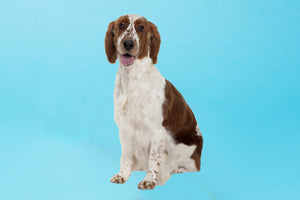
FREE UK DELIVERY ON ORDERS OVER £39.99
As the Basset Fauve de Bretagne is fairly social with both dogs and children, they can slot nicely into most households. However, they do require a good deal of exercise and would not suit a family who like to spend their day on the sofa.
It is thought that a number of hounds including the Basset Griffon Vendeen and the Dachshund were used in the creation of the Basset Fauve de Bretagne. They were specifically bred by the French to hunt alongside men on foot, rather than on horseback. Their short stature was advantageous when it came to flushing out small prey from warrens and deep vegetation. It was the ‘common people’ who employed this breed after the French revolution, rather than the royals or aristocrats.
Despite their charm, the number of Basset Fauve de Bretagne remains low in Great Britain today. Who knows, perhaps this will change over the next couple of decades?
One would be forgiven for mistaking the Basset Fauve de Bretagne for a cross-breed as their straight limbs, compact body and wiry coat aren’t typically of most pedigrees we see today. They were bred for purpose rather than appearance; a fact that has ensured their health through the years.
They have a domed skull, soulful hazel eyes and long, dangling ears which hang sweetly to the side of their face. Unsurprisingly, they are well-muscled and lean and there is a real power in their limbs.
Their harsh coat gave them protection from thorns and brambles when out hunting and they are a light brown colour, though can have white markings.
As is typical of a hound, the Basset Fauve de Bretagne does not lack in confidence and loves to be in on the action. They are rarely anxious or shy and will approach most situations with a bravery that belies their small stature.
Most agree that they are anecdotally less ‘high strung’ than other working dogs and will act even more mellow once they have been adequately exercised. Despite this, their prey drive remains high and they won’t hesitate to give chase to any nearby cat, rabbit or hamster.
Generally trusting of people and happy to be in their company, this is not a guard dog.
Unlike most pedigrees, the Basset Fauve de Bretagne is a hardy and healthy breed and there are not any genetic health conditions reported. This, of course, does not make them invincible! It does, however, mean that they should be generally healthier than pedigrees who were bred with more extreme conformations (such as the Pug or Frenchie).
When analysing the health data available, we must consider that there aren’t many Basset Fauve de Bretagne to study. This means that there may be health issues within the population that haven’t become apparent at this time.
Given the pendulous nature of their ears, one could assume that they may be prone to ear infections. It is sensible to keep a close eye on their ears, monitoring for redness within the canal or excess wax.
A dog that has been specifically bred to hunt, the Basset Fauve de Bretagne will be a Grade A pupil if the task they are given is related to hunting. They enjoy performing scent work and are obedient. For many, their recall is an area that will need working on as they can be lured away from their owner by the sight of a squirrel or the scent of a nearby rabbit.
The relatively short coat of the Basset Fauve de Bretagne does not need much in the way of grooming. A quick brush every day or two will keep the fur in good condition and remove any debris or dirt from the coat.
Baths are only required when the dog gets particularly dirty, perhaps after a cheeky roll in fox poo. Bathing too often will dry out their coat and may make them itchy.
Be sure to check their ears regularly and clean out wax every few weeks. Their claws may need clipping, especially as they get older. It is a good idea to get them used to this from a young age so they are not fearful around the claw clippers.
The Basset Fauve de Bretagne is by no means a lap dog. They are prized for their ability to run quickly and their stamina when hunting so they have a natural affinity for being outdoors. While they are suited to urban life, their owner needs to ensure they are provided with plenty of ‘work’ that is both mentally and physically stimulating.
If this dog is under-exercised they will quickly become bored. This can translate to destructive behaviour and nervous tendencies. A frustrated Basset Fauve de Bretagne may soon start to chew on your furniture or dig up your garden. To keep them in your good books, don’t neglect that exercise!
A little athlete, this breed benefits from a diet rich in high quality protein and healthy fats. They will also need plenty of carbohydrates; a source of slow release energy during exercise like long hikes. Carbohydrates can be provided as grains, sweet potatoes or corn.
Avoid over-feeding these dogs, particularly if they aren’t being exercised as much as they should be. In a small dog, this can quickly lead to obesity which will negatively impact their quality of life.
You'll find a handy feeding calculator on every product page here at Pooch & Mutt to help you identify how much of our health led recipes are right for the age, size and weight of your dog.
Never miss a treat!
Subscribe to our newsletter and get blog articles amongst other treats delivered to your inbox

Comments (0)
Leave a comment